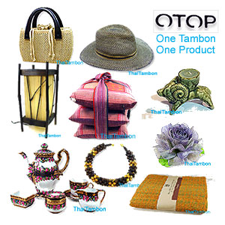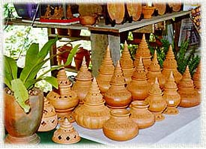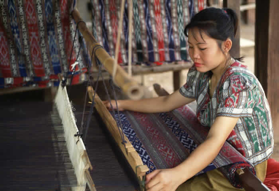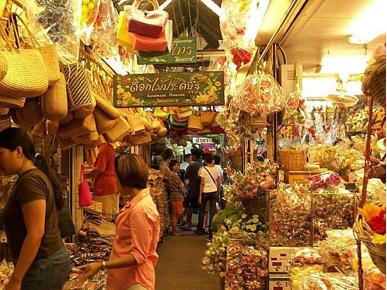OTOP - One Tambon One Product
OTOP
OTOP stands for ‘One Tambon (meaning sub-district) One Product’. It is a local entrepreneurship stimulus program which aims to support the unique locally made and marketed products of each Thai tambon all over Thailand.
OTOP drew its inspiration from Japan's successful One Village One Product (OVOP) programme, and encourages village communities to improve local product quality and marketing. It selects one superior product from each tambon to receive formal branding as a "starred OTOP product", and provides a local and international stage for the promotion of these products.
OTOP products cover a large array of local products, including handicrafts, cotton and silk garments, pottery, fashion accessories, household items, and foods.
So far a number of product groups have been classified for promotion; these include food items and beverages, textiles and clothing, woven handicrafts, artistry items, gifts, household and decorative items, and non-edible herbal products. These cover traditional items made in village communities, each lovingly crafted with the inimitable flavours and style of their localities.
Different regions are noted for specific types of products. Highlights of products from different regions in Thailand include:
NORTHERN THAILAND Superb handicrafts, particularly carved wood, silverware, specialty paper products, ceramics, bamboo baskets, cotton fabrics and silver jewellery from hill-tribe minorities.
NORTHEASTERN THAILAND OR I-SAN It is a tradition in the Northeast for villagers to make two sets of clothes - everyday work clothes and high quality silk items created with outstanding skill for special occasions like weddings and festivals. These latter items are being selected as OTOP products. Silk and cotton fabrics, especially tie-dyed mudmee designs. The most famous are Lai Khid and Phrae Wa silks. Other items include reed mats, baskets woven from water hyacinth and triangular pillows.
CENTRAL THAILAND
Traditional handicrafts of bamboo and bai lan, great earthen pots, Dan Kwian and Koh Kred pottery and terra cotta items.
EASTERN THAILAND
Famed for its fruits, fresh and processed, as well as bamboo and rattan baskets, reed mats and mudmee fabrics. SOUTHERN THAILAND Batik fabrics, woven products from lipao, bulrush and panan pandanus, mother-of-pearl inlays and carved wood products.
OTOP CHALLENGES
By its very nature, the OTOP project comes with its own set of challenges. In traditional societies, villagers would make products either for their own use or to be exchanged, bartered or sold to neighbours. These grassroots products are made during spare time, when farming or housework has been completed. Hence, production capacity and the ability to supply the volume of products required by buyers instantly becomes an issue.
With the introduction of OTOP, village communities are faced with the complex realities of trading beyond borders -- the issues of meeting deadlines, quality control, production capacity, design preferences and marketing challenges. Not all OTOP products in the past were of export quality.
Fortunately, many government agencies have been providing these village communities the necessary support. For instance, the OTOP Task Force of the Department of Export Promotion (DEP), Ministry of Commerce, develops activities that will assist in exporting OTOP products, such as the display of selected products at trade fairs in Thailand and overseas, as well as participating in in-store promotions and Thailand Exhibitions in other countries.
While the OTOP project aims to increase village incomes, the government is also offering a choice -- to go into OTOP production full time with plenty of government assistance. Major government agencies provide support: the Interior Ministry's Department of Community Development works directly with the villages to fine tune their products; the Industry's Ministry's Department of Industrial Promotion plays a key role in product development, skills training and quality control; the DEP's Product Development Centre employs teams of designers to work with villagers to create marketable designs and packages for their products.
Source: www.thaiembassy.sg/friends-of-thailand/p/what-is-otop




